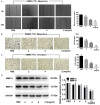Anticancer effect of fufang yiliu yin on human hepatocellular carcinoma SMMC-7721 cells
- PMID: 29511443
- PMCID: PMC5835814
Anticancer effect of fufang yiliu yin on human hepatocellular carcinoma SMMC-7721 cells
Abstract
Chinese herbal medicine utilizes clinically effective adjuvants that can potentiate the effects of hepatectomy and molecule-targeted drugs for the treatment of hepatocellular carcinoma (HCC). The aim of this study was to investigate the possible molecular mechanisms underlying the antitumor effect of fufang yiliu yin (FYY) on HCC cells. We investigated the effects of FYY on the proliferation, migration, invasion, and apoptosis of SMMC-7721 cells in vitro and in mouse subcutaneous xenograft models in vivo. FYY significantly inhibited the proliferation of SMMC-7721 cells compared to that of normal hepatocytes; cell proliferation was blocked at the G2/M phase in accordance with reduced expression of proliferating cell nuclear antigen. FYY treatment resulted in the activation of caspase-8, caspase-3 and poly (ADP-ribose) polymerase, with reduced protein levels of tumor necrosis factor receptor-associated factor 2, indicating an induction of cell apoptosis. In addition, we observed decreases in the protein expression of matrix metalloproteinase-2 and -9 along with an inhibition of cell migration and invasion after FYY treatment. Furthermore, FYY treatment significantly inhibited the growth of tumors in vivo. These data demonstrate the strong inhibitory effects of FYY on SMMC-7721 cells, and we propose FYY as a novel potential anticancer adjuvant.
Keywords: Chinese herbal medicine; Hepatocellular carcinoma; anticancer.
Conflict of interest statement
None.
Figures




Similar articles
-
Anticancer Effects of Fufang Yiliu Yin Formula on Colorectal Cancer Through Modulation of the PI3K/Akt Pathway and BCL-2 Family Proteins.Front Cell Dev Biol. 2020 Aug 11;8:704. doi: 10.3389/fcell.2020.00704. eCollection 2020. Front Cell Dev Biol. 2020. PMID: 32850824 Free PMC article.
-
Huaier Restrains Proliferative and Migratory Potential of Hepatocellular Carcinoma Cells Partially Through Decreased Yes-Associated Protein 1.J Cancer. 2017 Nov 6;8(19):4087-4097. doi: 10.7150/jca.21018. eCollection 2017. J Cancer. 2017. PMID: 29187885 Free PMC article.
-
Saponins isolated from Schizocapsa plantaginea inhibit human hepatocellular carcinoma cell growth in vivo and in vitro via mitogen-activated protein kinase signaling.Chin J Nat Med. 2018 Jan;16(1):29-40. doi: 10.1016/S1875-5364(18)30027-X. Chin J Nat Med. 2018. PMID: 29425588
-
Lupeol enhances radiosensitivity of human hepatocellular carcinoma cell line SMMC-7721 in vitro and in vivo.Int J Radiat Biol. 2015 Feb;91(2):202-8. doi: 10.3109/09553002.2015.966209. Epub 2015 Jan 27. Int J Radiat Biol. 2015. PMID: 25241960
-
Chinese herbal medicine-derived compounds for cancer therapy: a focus on hepatocellular carcinoma.J Ethnopharmacol. 2013 Oct 7;149(3):601-12. doi: 10.1016/j.jep.2013.07.030. Epub 2013 Aug 1. J Ethnopharmacol. 2013. PMID: 23916858 Review.
Cited by
-
Anticancer Effects of Fufang Yiliu Yin Formula on Colorectal Cancer Through Modulation of the PI3K/Akt Pathway and BCL-2 Family Proteins.Front Cell Dev Biol. 2020 Aug 11;8:704. doi: 10.3389/fcell.2020.00704. eCollection 2020. Front Cell Dev Biol. 2020. PMID: 32850824 Free PMC article.
-
Anticancer Effect of Radix Astragali on Cholangiocarcinoma In Vitro and Its Mechanism via Network Pharmacology.Med Sci Monit. 2020 Apr 4;26:e921162. doi: 10.12659/MSM.921162. Med Sci Monit. 2020. PMID: 32246704 Free PMC article.
References
-
- Caldwell S, Park SH. The epidemiology of hepatocellular cancer: from the perspectives of public health problem to tumor biology. J Gastroenterol. 2009;44(Suppl 19):96–101. - PubMed
-
- Chen W, Zheng R, Baade PD, Zhang S, Zeng H, Bray F, Jemal A, Yu XQ, He J. Cancer statistics in China, 2015. CA Cancer J Clin. 2016;66:115–132. - PubMed
LinkOut - more resources
Full Text Sources
Research Materials
